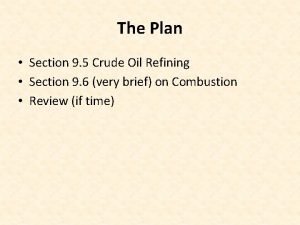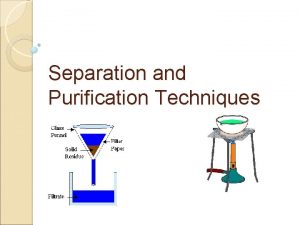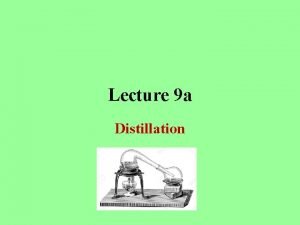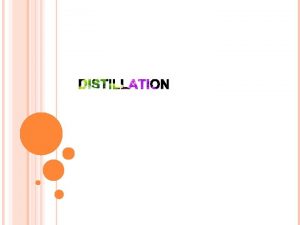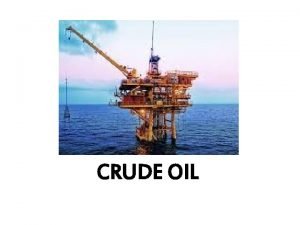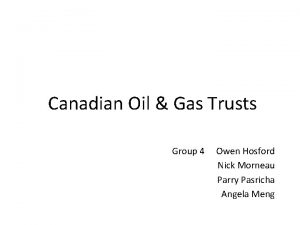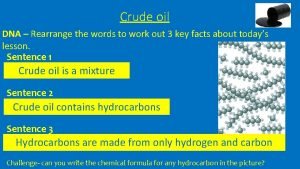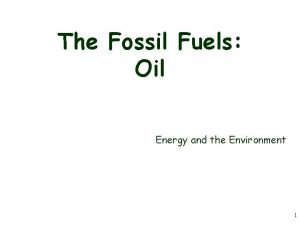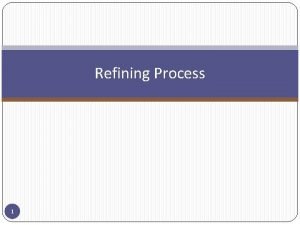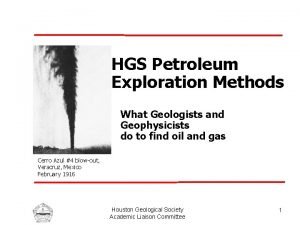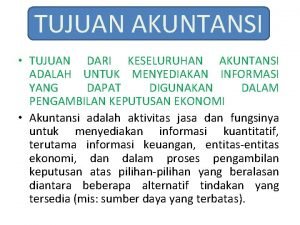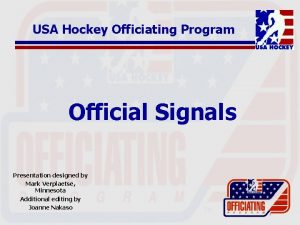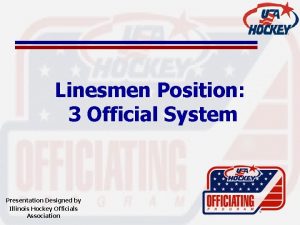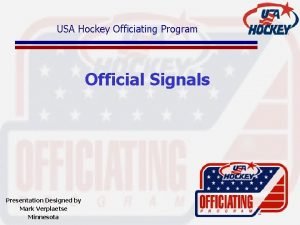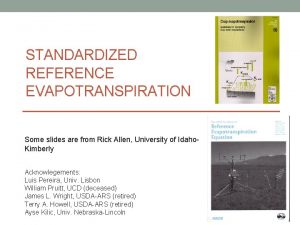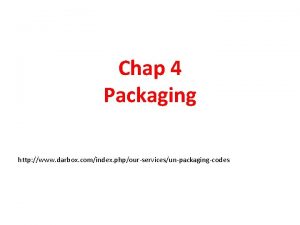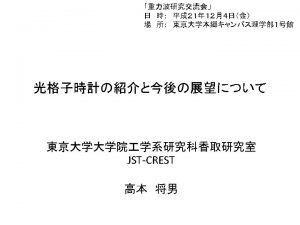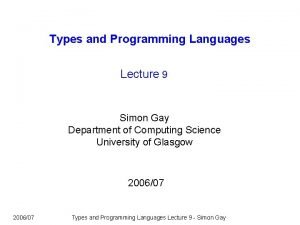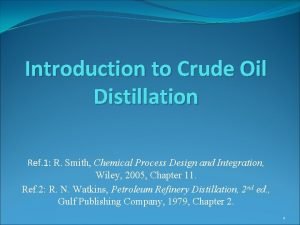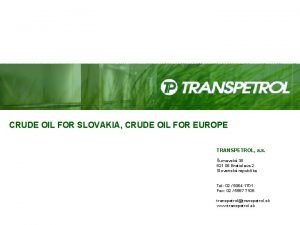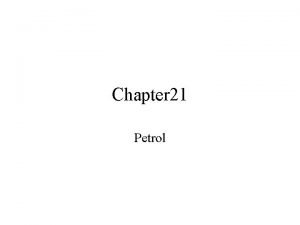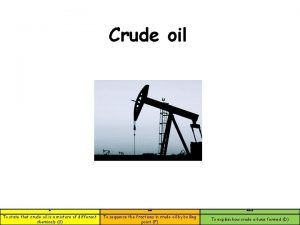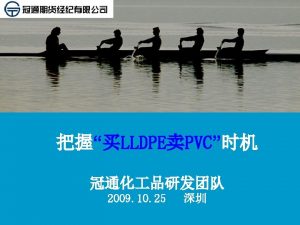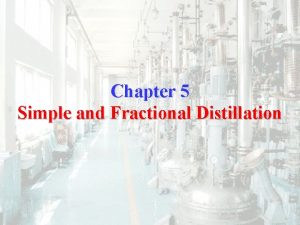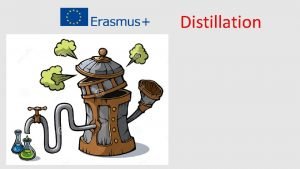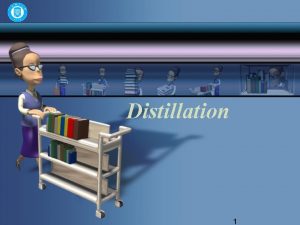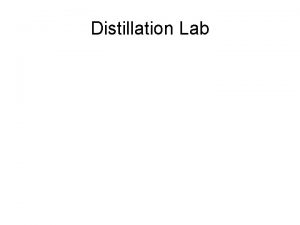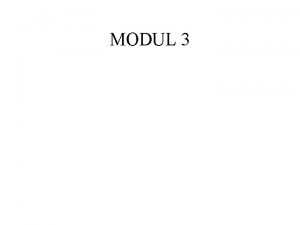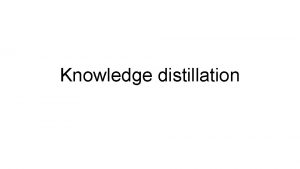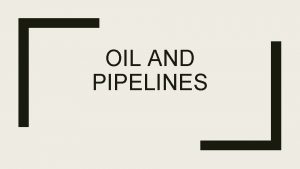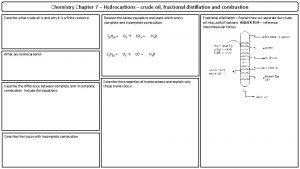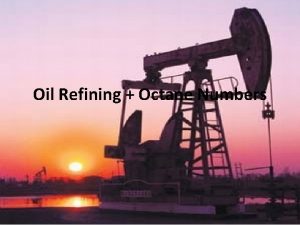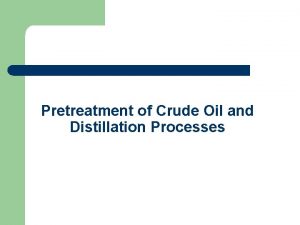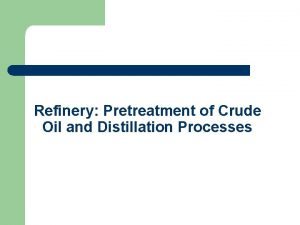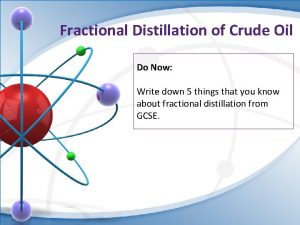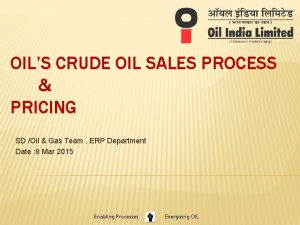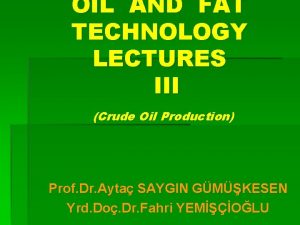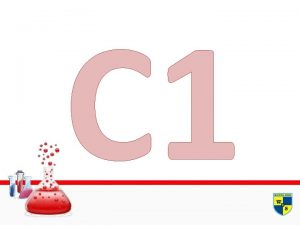Design Guidelines of Crude Oil Distillation Units Ref



























- Slides: 27

Design Guidelines of Crude Oil Distillation Units Ref. 1: M. Bagajewicz, Petroleum Fractionation-Overview, Lectures, 2007. Ref. 2: Y. A. Liu et al, Petroleum Refinery Process Modeling, Wiley-VCH, 2018 , Chapter 2. Ref. 3: HAT International, “Alpha Tray Design Sheet”, www. hatltd. com 1

Crude Oil Distillation Model development In general, the two major approaches for modeling columns are the rate-based and equilibrium-stage approach. In the rate-based approach, multistage operations are defined on the basis of rigorous heat and mass transfer rates between the vapor and liquid phases, and thermodynamic equilibrium between the vapor and liquid phases occurs at the vapor–liquid interface. This approach can be highly accurate and account for numerous phenomena including the physical layout of the column. However, this approach is also very demanding in terms of the parameter values required to produce a reasonable model. 2

Crude Oil Distillation Model development The more traditional approach for modeling multistage operations is the equilibrium-stage approach. In this approach, we consider each stage to separate the vapor–liquid mixture based on thermodynamics and on heat and mass balance constraints alone. 3

Crude Oil Distillation Model development We collectively refer to model Eqs. as Material, Equilibrium, Summation, and Heat equations or MESH equations. 4

Crude Oil Distillation Model development To simulate an actual column, we first convert the actual number of stages to an equivalent number of equilibrium stages by using an overall stage efficiency. Overall stage efficiency refers to the ratio of ideal (or theoretical) stages contained in the column (excluding the condenser and the reboiler) to the actual physical trays. For hydrocarbon distillation, the overall stage efficiencies are 50– 90%. For absorption processes, the range is 10– 50%. In general, the overall efficiency for crude oil distillation is roughly 0. 5 and the column model contains around 25 to 35 theoretical stages (excluding the side strippers). 5

Crude Oil Distillation Model development A popular method in dealing with the nonideal stage behavior in process simulators is to use an individual stage efficiency, called Murphree vapor stage efficiency. Users of process simulators often enter the actual number of stages or trays from the column process flow diagram (PFD) to the simulator and enter individual stage efficiency values independent of components, for different stages in the column such that the actual column operation is replicated. Unfortunately, many engineers do not understand the serious limitations of the individual stage efficiency models. 6

Crude Oil Distillation Model development There are no reports of typical individual stage efficiency values for petroleum columns. The user must then manipulate individual stage efficiency values in the column in order for the simulation results to match the plant data. This manipulation of individual stage efficiencies is similar to the regression fitting of data to an equation form. The worst consequence of using these individual stage efficiencies is that the simulation model would likely become useless for predicting the performance of the column at operating conditions different from those used to develop the column model, because the principle of equilibrium vapor and liquid leaving each stage has been violated. 7

Crude Oil Distillation Model development When modeling existing columns, we recommend to use a typical overall stage efficiency value to convert the actual number of trays (stages) to the equivalent number of theoretical stages. In this case the model predictions for a new set of operating conditions are correct. Separation section Theoretical stages Overall efficiency Column top to naphtha 6 to 8 0. 6 Naphtha to kerosene 4 to 6 0. 5 Kerosene to diesel 3 to 4 0. 5 Diesel to gas oil 4 to 6 0. 4 gas oil to flash zone 3 to 4 0. 3 Flash zone to bottom 1 to 2 0. 2 Open-steam side stripper 2 to 3 0. 3 Reboiled side stripper 3 to 4 0. 5 8

Crude Oil Distillation Design guidelines The first step in designing the atmospheric distillation column is the column pressure. The minimum pressure is the lowest permissible pressure in the reflux drum. The practical range is 0. 2 to 1. 0 psig. The design pressure drop across the condenser should be set to 5 psi. The allowable pressure drop for trays will be about 0. 1 to 0. 2 psi per tray. Most atmospheric towers have 20 to 28 theoretical stages between the flash zone and the tower top. So a pressure drop of 3 to 6 psi can be assumed between the flash zone and the tower top. A pressure drop of 5. 0 psi between the flash zone and the furnace outlet is recommended. 9

Crude Oil Distillation Design guidelines Volumetric flow of petroleum fractions can be estimated from TBP curve of crude oil based on TBP cut points as shown in the following Table: Petroleum fraction TBP cut points (o. F) Light ends IBP-100 Light straight run (LSR) 100 -220 Naphtha 220 -380 Kerosene 380 -480 Diesel 480 -610 Atmospheric gas oil (AGO) 610 -690 Light vacuum gas oil (LVGO) 690 -800 Heavy vacuum gas oil (HVGO) 800 -1000 Vacuum residue 1000 -FBP 10

Crude Oil Distillation Design guidelines The relationship between TBP cut points of petroleum fractions and whole TBP curve of petroleum fractions are shown in the following Figure. 11

Crude Oil Distillation Design guidelines TBP overlap is defined as (TBP EP of light fraction)-(TBP IP of heavy fraction) 12

Crude Oil Distillation Design guidelines The recommended specifications for petroleum fractions, ASTM D 86 at 95% point, and (5 -95) gap are shown in the following Tables: Petroleum fraction LSR ASTM D 86, 95% (o. F) 210 -250 Naphtha 360 Kerosene 520 Diesel 620 Atmospheric gas oil (AGO) Petroleum fraction 710 -770 (5 -95) gap (o. F) Naphtha - LSR ≥ 30 Kerosene - Naphtha ≥ 30 Diesel - Kerosene ≥ 0 AGO - Diesel -10 to -20 13

Crude Oil Distillation Design guidelines The required flowrate of steam in side strippers and main column can be estimated based on the following guideline: lb of steam/bbl of product = 8 to 10 The original purpose of adding pump-around circuits was to reduce vapor and liquid traffic at the top section of the column. Without pump-around circuits, all condensation heat has to be removed from the condenser, which results in a large vapor flowrate at the top trays. 14

Crude Oil Distillation Design guidelines The presence of the pump-around circuit decreases the number of effective ideal trays. The effect can be even more detrimental to separation if the flowrate of a pump-around circuit is increased. These effects can be compensated to a certain extent by increasing the steam rate in the side strippers. Another solution is to increase the number of trays. However, with the constant total number of trays, the relationship between heat recovery and steam consumption can be incorporated into the design procedure. 15

Column Internals Trays Types There are three types of cross-flow trays: (1) sieve, (2) valve and (3) bubble cap. 16

Column Internals Trays Types 17

Column Internals Trays Types 18

Column Internals Trays Types 19

Comparing Trays Performance The principle factors in comparing the performance of trays are: Cost: Bubble-caps are appreciably more expensive than sieve or valve trays. Due to its simple design, sieve trays are normally the cheapest. (Rel. Cost: 1. 0 sieve, 1. 2 valve, 2. 0 bubble-cap) Turndown Ratio: The ratio of the highest to the lowest flowrates of vapor over which the tray will operate satisfactorily. Bubble-cap trays have the highest turndown ratio, followed by valve tray (up to 10), and sieve tray (up to 2). 20

Comparing Trays Performance Pressure Drop: The tray pressure drop will depend on the detailed design of the tray, but in general, sieve trays give the lowest pressure drop, followed by valves, and bubble-caps. Maintenance: For dirty services, bubble-caps are not suitable as they are most susceptible to plugging. Sieve trays are the easiest to clean. 21

Trays Operation Limits Jet Flood is the criteria used to predict the point at which massive liquid carryover will occur due to the height of spray on the tray deck exceeding the available tray space. It is normal practice to limit tray design to a maximum of 80% of jet flood to allow a safety margin on tower control, possible discrepancies of VLE data and also the limitations of the flooding correlation used. 22

Trays Operation Limits Entrainment Limit is reached when the velocity of vapor through the tray open area is high enough to project liquid droplets to the tray above. Weeping occurs when the velocity of the vapor through the tray open area is too low to prevent liquid from leaking through the open area thus by-passing contact area to the tray below. Most valve and sieve trays will weep in normal operation (less than 10%). 23

Trays Operation Limits Blowing Flood occurs at low liquid rates at which the tray operates in the spray regime resulting in massive entrainment of liquid to the tray above to the extent that the tray deck is essentially blown dry. Downcomer Choke Flood occurs at high liquid loads when the downcomers are too small to allow effective vapor disengagement causing vapor entrainment to the tray below. 24

Trays Operation Limits Downcomer Back-up occurs when the head of liquid (aerated) in the downcomer backs up onto the tray deck. Other operation limits that may be used are: Minimum weir loading, Maximum weir loading and Maximum pressure drop. 25

Trays Geometry 26

Trays Geometry 27
 Mnemonic for fractional distillation of crude oil
Mnemonic for fractional distillation of crude oil Simple distillation vs fractional distillation
Simple distillation vs fractional distillation Introduction to distillation
Introduction to distillation Define molecular distillation
Define molecular distillation How is crude oil formed
How is crude oil formed Synthetic crude oil
Synthetic crude oil Crude oil contains
Crude oil contains Crude oil
Crude oil Naphthenes in crude oil
Naphthenes in crude oil What is crude oil made of
What is crude oil made of Primary emulsion example
Primary emulsion example Botox crow's feet injection sites
Botox crow's feet injection sites When units manufactured exceed units sold:
When units manufactured exceed units sold: Laporan perubahan modal
Laporan perubahan modal Ref 2021 twitter
Ref 2021 twitter Post ref in journal entry
Post ref in journal entry Mekanisme debit kredit
Mekanisme debit kredit Twitter ref 2021
Twitter ref 2021 Hockey ref penalty signals
Hockey ref penalty signals Ref criteria
Ref criteria 3 man system hockey linesman
3 man system hockey linesman Ice hockey penalty signals
Ice hockey penalty signals Ref et idaho
Ref et idaho Katholische kirche rothrist
Katholische kirche rothrist Packages_display.php?ref=
Packages_display.php?ref= Volleyball ref stand
Volleyball ref stand Divider slide
Divider slide Bakla typings
Bakla typings
